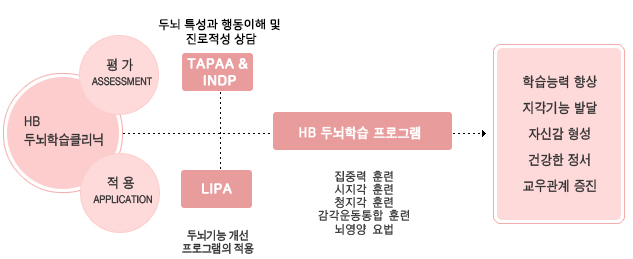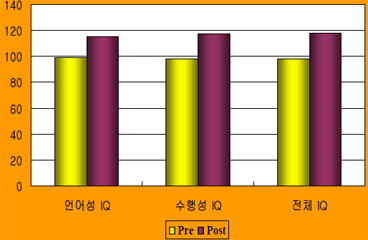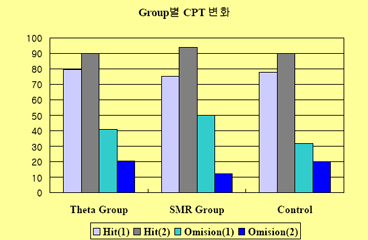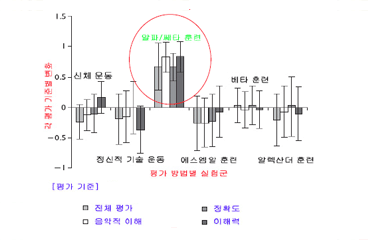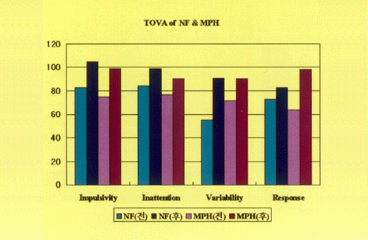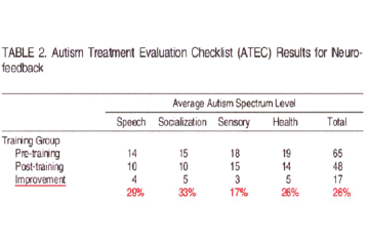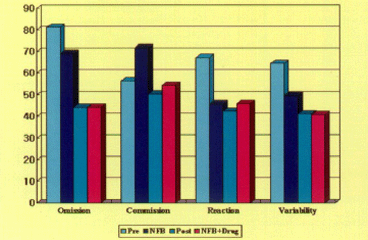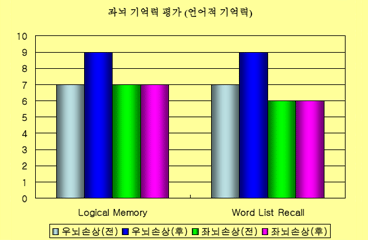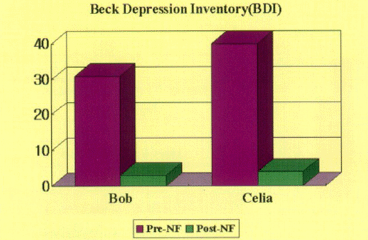
집중력 훈련을 위한 NeuroComp System
· Changes in IQ
학습장애아 24명
(나이: 7 -16세, 평균 IQ : 98)
Beta/SMR 매주 1회, 평균 28회
평균 IQ : 118, IQ 20점 상승
Tansey Report : WISC-R Results 1991, Aus J of Psycho. Vol 43, 147-153, 1991.
· Working Memory
영국 의대생 30명
(평균 나이: 22.1세)
1그룹: SMR 훈련 / 2그룹: A-T 훈련
(뉴로피드백 1회/주, 8회 실시)
CPT 검사
SMR 훈련 그룹 인지능력 상승
The effect of training distinct neurofeedback protocols on aspects of cognitive performance. Vernon D, Egner et al. Int
J of Psychophy 47: 75-85, 2003.
· Peak Performance
영국 음대생 61명
(6그룹으로 구분)
1그룹: SMR 훈련 / 2그룹: Beta 훈련
3그룹: A-T 훈련 / 4그룹: 육체 훈련
5그룹: 정신기술훈련
6그룹: Alexander 훈련
(뉴로피드백 2회/주, 총 10회)
Alpha/Theta 그룹 음악능력 향상
Ecological validity of neurofeedback: modulation of slow wave EEG enhances musical performance.
Egner T, Gruzelier JH. Neuroreport. 2003 Jul 1;14(9):1221-4.
· Neurofeedback Vs. Medication
ADHD 환자 34명
(2그룹으로 구분)
1그룹 (22명, 9.8세): Beta/SMR 훈련
2그룹 (12명, 9.6세): 약물치료(MPH)
(3회/주, 총 36회 실시)
유사한 치료 효과 보임
Neurofeedback treatment for attention-deficit/hyperactivity disorder in children: a comparison with methylphenidate.
Fuchs T, Birbaumer N, Lutzenberger W, Gruzelier JH, Kaiser J. Appl Psychophysiol Biofeedback. 2003 Mar;28(1):1-12.
· Autism
자폐아 환자 40명
(실험군-20명, 대조군-20명) ↓
실험군 Beta/SMR 훈련 실시
(평균 36회: 20-69회)
실험군: 평균 26% 개선효과
대조군: 변화 없음
Efficacy of Neurofeedback for Children in the Autistic Spectrum: A Pilot Study. Jarusiewicz B. Journal of Neurotherapy,
Vol 6(4), 2002. pp. 39-49.
· Adult ADHD
성인 ADHD 환자 (36세 여자)
(간질, 성격 장애 동반)
Beta/SMR훈련과 약물치료 병행
(20회 훈련 후 약물 투여 중단)
총 30회 실시 제반 증상 개선
Neurotherapy and drug therapy in combination for adult ADHD, personality disorder, and seizure disorder: A case report.
Hansen, LM, Trudeau DL, Grace DL. Journal of Neurotherapy, Vol 2(1), Fal-Win 1996. pp. 6-14.
· Memory Performance
간질 환자 24명
(좌뇌손상: 13명, 우뇌손상: 7명)
SMR 훈련 → 좌,우뇌 기억력평가 상승
Changes in Lateralized Memory Performance in Subjects with Epilepsy Following Neurofeedback Training.
Sterman MB, Lantz DL. Journal of Neurotherapy, Vol 5(1-2), 2001. pp. 63-72.
· Mood Disorder
Bob(38세-남): Dysthymic D.
Celia(36세-여): Maj. Depressive D.
Bipolar(F3-F4) Alpha asymmetry
(평균 27회 실시)
우울증 수치(BDI score) 매우 낮아짐
Clinical use of an alpha asymmetry neurofeedback protocol in the treatment of mood disorders: Follow-up study one to
five years post therapy. Baehr E, Rosenfeld JP, Baehr R. Journal of Neurotherapy, Vol 4(4), 2001. pp. 11-18.

HTS, PVT, PTS II에 대한 임상 연구
-Cooper J, Sherman J. Comparison Of Lower Order Aberrations Measured with The Z-Aberrometer, Humphrey Automated Refractor, and Subjective Evaluation. Submitted Clinical and Experimental Optometry, 2008
-Cooper J, Felderman J. Reduction of Asthenopia in Non-Strabismic Binocular Anomalies Using Computerized Home Therapy - HTS submitted Optometry, 2008
-Kulp. M. T., E. Borsting, Mitchell, G. L., Scheiman, M., Cotter, S., Cooper, J. et al. "The Feasibility of using placebo vision therapy in a multicenter clinical trial." Optom Vis Sci. 2008: 85(4): 255-61.
-Cooper J. Computerized Vision Therapy for Home and Office Treatment of Accommodative & Vergence Disorders, & Amblyopia. J Behavioral Optometry. 2007:88-93.
-Bass SJ, Cooper J, Feldman, Horn D. Comparison of an Automated Confrontation Testing Devise vs Finger Counting in the Detection of Visual Field Loss. Optometry. 2007:390-395
-Scheiman M, Cotter S, Rouse M, Mitchell GL, Kulp M, Cooper J, Borsting E; - Convergence Insufficiency Treatment Trial Study Group. Randomised clinical trial of the effectiveness of base-in prism reading glasses versus placebo reading glasses for symptomatic convergence insufficiency in children. Br J Ophthalmol. 2005;89(10):1318-23.
-Colavito J, Cooper J, Ciuffreda K. Non-Ptotic Ocular Myasthenia Gravis: A Common Presentation of an Uncommon Disease. Optometry. 2005:76(7):363-75.
-Scheiman M, Mitchell L, Cotter S, Kulp M, Cooper J, Rouse M, Borsting E, London R, Wensveen J. Convergence Insufficiency Treatment Trial (CITT) Study Group. A Randomized Clinical Trial of Vision Therapy/Orthoptics versus Pencil Pushups for the Treatment of Convergence Insufficiency in Young Adults. Optometry and Vision Sciences. 2005, 82:583-593.
-Cooper J, Carlson P, Gelfond I, , Campolattaro B, Wang F. Comparison of Eccentric Fixation Measurements Using the Streak Target of an Ophthalmoscope and Traditional Visusocopy Target. J Ped Strab 42(2):89-96, 2005.
-Scheiman M, Mitchell L, Cotter S, Cooper J, Kulp M, Rouse M, Borsting E, London R, Wensveen J. Convergence Insufficiency Treatment Trial (CITT) Study Group. A Randomized Clinical Trial of Treatments for Convergence Insufficiency in Children. Arch Ophthalmol 123(1):14-24,2005.
-Canellos HM, Cooper J, Paek A, Chien J. Multiple Calcified Deposits Along Eyelids Secondary to Chronic Renal Failure and Hyperparathyroidism. Optometry 76(3):181-4, 2005.
-Borsting E, Rouse MW, Mitchell GL, Scheiman M, Cotter SA, Cooper J, Kulp MT, London R, and The Convergence Insufficiency Treatment Trial Group. Validity and Reliability of the Revised Convergence Insufficiency Symptom Survey in Children Aged 9 to 18 Years. Optom Vis Sci; 80(12):832-838, 2003.
-Scheiman M, Cooper J, Mitchell L, DeLand P, Cotter S, Borsting E, London R, Rouse M. A Survey of Treatment Modalities for Convergence Insufficiency. Optom. Vis. Sci. 79(3):151-157, 2002.
-Cooper J, Feldman J, Pasner K. Intermittent Exotropia: Stimulus Characteristics Affect Tests for Retinal Correspondence and Suppression. Bin Vis & Eye Mus Qtly. 15(2):131-140, 2000
-Cooper J, Pollack G, Ciuffreda K, Kruger, Feldman J. Accommodative and Vergence Findings in Myasthenia Gravis: A Case Report. Journal Neuro-Ophthalmology. 20(1): 5-11, 2000.
-Uche A, Cooper J Feldman J, Janus S, Digman K. The Clinical Efficacy of Paremyd with and without Dapiprazole in Subjects with Light and Dark Brown Irides. Optometry and Vis. Sci. 76:94-101, 1999.
-Cooper J. Diagnosis and Treatment of Accommodative and Vergence Anomalies Using Computerized Vision Therapy. Practical Optometry. 9:6-10, 1998.
-Cooper J, Burns C, Cotter S, Daum KM, Griffin JR, Scheiman M. Optometric Clinical Guideline: Care of the Patient With Accommodative or Vergence Dysfunction. Am. Optom. Ass. 1998.
-Cooper J. Intermittent Exotropia of the Divergence Excess Type - A View Point Journal of Behavioral Optometry, 1997.
-Cooper J, Feldman J, Janus S, Appleman W, Appel S, Horn D. Pupillary Dilation and Funduscopy with 1% Hydroamphetamine Plus .25% Tropicamide (Paremyd) Versus Tropicamide (.5% Or 1%) as a Function of Iris and Skin Pigmentation, and Age. J Am Opt Ass . 67(11):669-75, 1996.
-Cooper J, Ciuffreda KJ, Carniglia PE, , Zinn KM, Tannen B. Orthoptic treatment and eye movement recordings in Guillain-Barre’ syndrome. A case report. Neuro-ophthalmology 15(5):249-256, 1995.
-Cooper J, Medow N. Correspondence: Sensory Status in Intermittent Exotropia. Bin Vis Eye Mus Surg Qtly. 9:11-12, 1994.
-Cooper J, Medow N. Intermittent Exotropia of the Divergence Excess Type: Basic and divergence excess type (major review). Bin Vis Eye Mus Surg Qtly 8:187-222, 1993.
-Cooper J, Feldman J, Eichler R. Relative Strength of Central and Peripheral Fusion as a Function of Stimulus Parameters. Opt. Vis Sci, 69: 1992.
-Feldman JM., Cooper J,Eichler R. Effect of Various Stimulus Parameters on Fusional Horizontal Amplitudes in Normal Humans. Bin Vis Eye Mus Surg Qtly 8:23-32, 1993.
-Cooper, J. Clinical Implications of Vergence Adaptation. Opt Vis Sci, 69 (4): 300-307, 1992.
-Carniglia P, Cooper J. Vergence Adaptation in Esotropia. Opt Vis Sci, 69 (4): 308-313, 1992.
-Feldman J, Cooper J, Reinstein F, Swiatoca J. Asthenopia Induced by Computer-Generated Fusional Vergence Targets. Opt Vis Sci, 69: 710-716, 1992.
-Cooper, J. Ch. 14: Stereopsis. In Procedures in Optometry. Eds. Amos J., Eskridge B. Bartlett Lippencott, 1991.
-Lieberman, S., Cooper, J. Single Maxillary Central Incisor Syndrome: Associated Bilateral Duane's Syndrome. Bin Vis Qtly 6:151-154,1991.
-Feldman J, Cooper J, Carniglia P, Schiff FM, Sheete TN. Comparison of Fusional Ranges Measured by Risley Prisms, Vectograms, and Computer Orthoptics, Optom and Vis Sci 66(6): 375-382, 1989.
-Cooper, J., Kruger, P. and Panariello, G.F., The Pathognomonic Pattern of Accommodative Fatigue in Myasthenia Gravis. Binocular Vision. 3:141-148, 1988.
-Cooper J. Review of Computerized Orthoptics with Specific Regard to Convergence Insufficiency. Am. J. of Optom. and Phys. Optics. 65(6): 455-463, 1988.
-Cooper, J. Orthoptic Treatment of Vertical Deviations. J Amer Optom Ass. 59 (6): 463-468, 1988.
-Cooper J., "Diagnosis and Remediation of Accommodative Anomalies", Chapter in Clinical Diagnosis of Optometric Problem Ed: John Amos Butterworth Publications, 1987.
-Cooper J., Feldman J.M., Selenow A., Fair R., Bucciero F., MacDonald D., and Levy M. Reduction of Asthenopia Following Accommodative Facility Training. Am J Optom Physiol Opt. 64, 30-436, 1987.
-Sutija VG, Eiden SB, Wicjer DM, Horn D, Cooper J, and Appleman W. Electrophysiological Assessment of Visual Deficit in Glaucoma. Appl. Optics, 26, 1421-1431, 1987.
-Eiden B, Cooper J, Horn D, and London R. Inter-examiner Reliability of the Cup to Disc Ratio Assessment. Am. J of Opt. & Phys. Optics, 73: 9, 1986.
-Cooper J, Record CD. Suppression and Retinal Correspondence in Intermittent Exotropia. British Journal of Ophthalmology. 700: 673-676, 1986.
-Schnider C, Ciuffreda K, Cooper J, and Kruger P. Accommodation Dynamics in Divergence Excess Exotropia. Investigative Ophthalmology, 25: 414-418, 1984.
-Cooper J, Selenow A, Ciuffreda J, Feldman J, Faverty J, and Hokoda S. Reduction of Asthenopia in Patients with Convergence Insufficiency Following Fusional Vergence Training. Am J Opt Physl Opt, 60: 982-989,1983.
-Cooper J, Citron M. Microcomputer Produced Anaglyphs for Evaluation and Therapy of Binocular Anomalies. Journal of the American Optometric Association, 65: 185-188, 1983.
-Panariello G, Cooper J. Surgical and Post Surgical Complications from Cataract Extraction. Journal of the American Optometric Association, 54: 710-720, 1983.
-Cooper J, Ciuffreda K, and Kruger P. Stimulus and Response AC/A Ratios in Intermittent Exotropia of the Divergence Excess Type. British Journal of Ophthalmology, 66(6): 398-904, 1982.
-Cooper J, Dibble C. Mortality Rates in Strabismic Surgery. Journal of the American Optometric Association, 53(5): 391-395, 1982.
-Cooper J, Horn D, Dibble C. Reliability of fixation disparity curves. Am J Optom Phys Opt. 58:960-64, 1981.
-Feldman J, Cooper J. Rapid Assessment of Stereopsis in Preverbal Children Using Operant Techniques: A Preliminary Study. Journal of the American Optometric Association, 51(8): 767-771, 1980.
-Cooper J, Feldman J. Operant Conditioning of Fusional Convergence Ranges Using Random Dot Stereograms. American Journal of Optometry & Physiological Optics, 57(4): 205-213, 1980.
-Cooper J, Feldman J. Assessing the Frisby Stereo Test Under Monocular Viewing Conditions. Journal of the American Optometric Association, 50(7): 807-809, 1979.
-Cooper J, Feldman J. Panoramic Viewing, Visual Acuity of the Deviating Eye and Anomalous Retinal Correspondence in the Intermittent Exotropia of the Divergence Excess Type. American Journal of Optometry & Psychological Optics, 56(7): 422-429, 1979.
-Cooper J, Feldman J, Medlin D. Comparing Stereoscopic Performance of Children Using the Titmus, TNO, and Randot Stereo Tests. Journal of the American Optometric Association, 50(7): 821-825, 1979.
-Sherman J, Cooper J. Advanced Diagnostic Procedure for Evaluating the Visual Status of the Child. Journal of the American Optometric Association, 50(10): 1139-1149, 1979.
-Cooper J. Clinical Stereopsis Testing: Contour and Random Dot Stereograms. Journal of the American Optometric Association, 50(1): 41-46, 1979.
-Cooper J, Feldman J. Random Dot Stereogram Performance by Strabismic, Amblyopic and Ocular Pathology Patients in an Operant Discrimination Task. American Journal of Optometry & Physiological Optics, 55(9): 599-609, 1978.
-Cooper J, Feldman J. Operant Conditioning and the Assessment of Stereopsis in Young Children. American Journal of Optometry & Physiological Optics, 55(8): 532-542, 1978.
-Cooper J, Duckman R. Convergence Insufficiency: Diagnosis and Treatment. Journal of the American Optometric Association, 49(6):, 1978.
-Cooper J. A Case Report: Treatment of a Decompensating Esotropia Who Had Diplopia and Vertex Headaches. Journal of American Optometric Association, 48(12): 1557-1558, 1977.
-Cooper J, Warshowsky J. Lateral Displacement as a Response Cue in the Titmus Stereo Test. American Journal of Optometry & Physiological Optics, 54(8):, 1977.
-Cooper J. Intermittent Exotropia of the Divergence Excess Type. Journal of the American Optometric Association, 48(10): 1251-1273, 1977.
-Cooper J. Random Dot Stereopsis in Advanced Diagnostic Procedures. Ed: J. Sherman, Optometric Extension Program, 2 (1&2): 1-13, 1976.
-Lieberman S, Pollard S, Cooper J, Flax N. The Utilization of a Consulting Clinical Psychologist Within an Urban Vision Training Clinic. American Journal of Optometry & Physiological Optics, 57(7): 493-481, 1974.
-Cooper J, Lieberman S, Flax N. Analysis of Optometric Findings Using a Punch Card Retrieval System. American Journal of Optometry & Physiological Optics, 52(7): 478-481, 1974.

HTS, PVT, PTS II에 대한 임상 연구
-Ludlow, A., Wilkins, A., & Heaton, Pam. The effect of colored overlays on reading ability in children with Autism. Journal of Autism and Developmental Disorders. Spring 2006.
-Sparkes, D.L., Robinson, G.L., Roberts, T.K., Dunstan, R.H. General Health and Associated Biochemistry in a Vusual-Perceptual Subtype of Dyslexia. Learning Disabilities: New Research, Nova Science Pub., New York, 81-98, 2006.
-Kumagai, Keiko, PhD. Published paper. University of Tsukuba, Japan. Effect of colored films related in facilitating reading: The result of the General Japanese population and a dyslexic student, 2006.
-Steiner, Fritz. Schleudertrauma und visuelle Wahrnehmungsstorungen. Schleudertrauma-Info, S., 22-26, 2005.
-Kriss, Isla, & Bruce J.W. Evans. The relationship between dyslexia and Meares-Irlen Syndrome. Journal of Research in Reading, 28 (3) 350-364, 2005.
-Steiner, Fritz. Die Irlen Methode zur Behandlung von Leseschwaeche. Interdisziplinaeres Lehrubuch zur Behandlung von Lern- und Leseschwierigkeiten, SZH/CSPS, Schweizerische Zentralstelle fur Heillpaedagogik 2005, 193-215, 2005.
-Taubenschmid, Margit. Visuelle Wahrnemungsschwaeche und Irlen-Syndrom. Erziehungswissenschaftliche Forschung - Paedagogische Praxis, Reihe der Abteilung fuer Empirische Erziehungswissenschaft des Instituts fuer erziehungswissenschaft der Universitaet Wien, Peter lang, Europaeischer Verlag der Wissenschaften, Frankfurt 2005.
-Singleton, C. & Trotter, S. Visual stress in adults with and without dyslexia. Journal of Research in Reading, 28(3) 365-378, 2005.
-Ray, N.J., Fowler, S., & Stein, J.F. Yellow filters can improve magnocellular function: motion sensitivity, convergence, accommodation, and reading. Annals N.Y. Academy of Science, 1039, 283-293, 2005.
-Noble, J., Orton, M., Irlen, S., Robinson, G. A controlled field study of the use of coloured overlays on reading achievement. Australian Journal of Learning Disabilities, 9, 14-22, 2004.
-Robinson, G.L., & Foreman, P.J. The family incidence of a visual-perceptual subtype of dyslexia. Focus on Dyslexia Research Nova Science Publishers, Inc., 27-40, 2004.
-Robinson, G.L., Foreman, P.J., Dear, K.G.B., and Sparkes, D. The Family Incidence of a Visual-Perceptual Subtype of Dyslexia. Nova Science Publishers, 27-40, 2004.
-Wilkins, A.J., Huang, J., & Cao, Y. Visual stress theory and its application to reading and reading tests. Journal of research in Reading, 27(2), 152-162, 2004.
-Floyd, R.A., Dain, S.J., Elliott, R.T. Is the perception of brightness different in poor readers? School of Optometry and Vision Science, University of new South Walkes, NSW 2052, Sydney, Australia, Vision Research, Jan: 44(2), 221-7, 2004.
-Cheng, A., Eysel, U., & Vidyasagar, T. The role of the magnocellular pathway in serial deployment of visual attention. European Journal of Neuroscience, 20(8), 2188-2192, 2004.
-Chase, C., Ashourzadeh, A., Kelly, C., Monfette, S., & Kinsey, K. Can the magnocullular pathway read? Evidence from studies of color. Vision Research, 43, 1211-1222, 2003.
-Robinson, G.L., & Whiting, P.R. The interpretation of emotion from facial expression for children with visual processing problems. Australasian Journal of Special Education, 27(2), 50-67, 2003.
-Stein, John. Visual motion sensitivity and reading. Neuropsychologia, 41, 1785-1793, 2003.
-Sparks, D.L., Robinson, G.L., Dunstan, H., & Roberts, T.K. Plasma cholesterol levels and Irlen Syndrome: preliminary study of 10- to 17-yr., old students. Perceptual and Motor Skills, 97, 745-752, 2003.
-Bouldoukian, J.,, Wilkins, A.J., & Evans, Bruce J.W. Randomised controlled trial of the effect of coloured overlays on the rate of reading of people with specific learning difficulties. Ophthalmological and Physiological Optics, 22, 55-60, 2002.
-Evans, Bruce J.W., & Joseph, Florence The effect of coloured filters on the rate of reading in an adults student population. Opthalmological and Physiological Optics, 22, 535-545, 2002.
-Scott, L., McWhinnie, H., Taylor, L., Stevenson, N., Irons, P., Lewis E., Evans, M., Evans, B., & Wilkins, A. Coloured overlays in schools: orthoptic and optometric findings. Ophthalmological and Physiological Optics, 22, 156-165, 2002.
-Wilkins, Arnold. Coloured overlays and their effects on reading speed: a review. Opthalmological and Physiological Optics, 22, 448-454, 2002.
-Robinson, G.L., Roberts, T.K., McGregor, N.R., Dunstan, R.H. & Butt, H. Biochemical Analysis of People with Chronic Fatigue Who Have Irlen Syndrome: Speculation Concerning Immune System Dysfunction. Perceptual and Motor Skills. 93, 486-504, 2001.
-Robinson, G.L., McGregor, N.R., Roberts, T.K., Dunstan, R.H., & Butt, H. A biochemical analysis of people with chronic fatigue who have Irlen syndrome: speculation concerning immune system dysfunction. Perceptual and Motor Skills, 93, 486-504, 2001.
-Whiting, P.R., & Robinson, G.L. The interpretation of emotion from facial expressions for children with a visual sub-type of dyslexia. Australian Journal of Learning Disabilities, 6,(4), 6-14, 2001.
-Whiteley, H.E., & Smith, C.D. The Use of Tinted Lenses to Alleviate Reading Difficulties. Journal of Research in Reading, 24(1), 30-40, 2001.
-Wilkins, A.J., Lewis, E., Smith, F., Rowland, E., & Tweedie, W. Coloured overlays and their benefit for reading. Journal of Research in reading, 24(1), 41-64, 2001.
-Romani, A., Conte, S., Callieco, R., Bergamaschi, R., Versino, M., Lanzi, G., Zambrino, C.A., & Cosi, V. Visual evoked potential abnormalities in dyslexic children. Functional Neurology, 16(3), 219-229, 2001.
-Pammer, K., & Lovegrove W. The influence of color on transient system activity: implications for dyslexia research. Perception & Psychophysics, 63(3), 490-500, 2001.
-Pammer, K., & Wheatley, C. Isolating the M(y)-cell response in dyslexia using the spatial frequency doubling illusion. Vision Research, 41, 2139-2147, 2001.
-Breitmeyer, B.F., & Ogmen, H. Recent models and findings in visual backward masking: a comparison, review, and update. Perception & Psychophysics, 62(8), 2000.
-Talcott, J., Hansen, P.C., Assoku, E.L., & Stein, J. Visual motion sensitivity in dyslexia: evidence for temporal and energy integration deficits. Neuropsychologia, 38, 935-943, 2000.
-Robinson, G.L., Roberts, T.K., McGregor, N.R., & Barbolini, G., A biochemical analysis of people with chronic fatigue who have Irlen syndrome. Paper presented to the 6th Irlen International Conference, Australia. 5-8 July 2000.
-Temple, M. Some of the effects of Irlen syndrome on gifted students. Paper presented to the 6th Irlen International Conference, Australia. 5-8 July 2000.
-Whichard, J.A., Feller, R.W., & Kastner, R. The Incidence of Scotopic Sensitivity Syndrome in Colorado Inmates. Journal of Correctional Education, 51(3), 294-299, 2000.
-Whiting, P.R. Assessment for dyslexia. Paper presented to the 6th Irlen International Conference, Australia. 5-8 July, 2000.
-Skottun, B.C. The magnocellular deficit theory of dyslexia: the evidence from contrast sensitivity. Vision Research, 40, 111-127, 2000.
-Conlon, E. Visual Perceptual Problems in Reading: Their relationship to reading disability and neural processing. Paper presented to the 6th Irlen International Conference, Australia. 5-8 July, 2000.
-Hazell, P, Still Going. Hyperactivity Enters its Second Century. Paper presented to the 6th Irlen International Conference, Australia 5-8 July, 2000.
-Anstice, J. Eye movements: Their importance for reading and some of the factors that disrupt them. Paper presented to the 6th Irlen International Conference, Australia, 5-8 July, 2000.
-Irlen, H. Looking beyond the printed page. Paper presented to the 6th Irlen International Conference, Australia. 5-8 July, 2000.
-Johnson, P.J., Saba, G., Dorain, E., Belmont, S. A Study to test the effectiveness of reading with Irlen coloured overlays for students with Irlen/Scotopic sensitivity syndrome. Paper presented to the 6th Irlen International Conference, Australia. 5-8 July, 2000.
-Robinson, G.L. Irlen coloured filters and adults. Australian Journal of Learning Disabilities, 5(1), 15-23, 2000.
-Robinson, G.L., & Conway, R.N.F. Irlen lenses and adults: a small scale study of reading speed, accuracy, comprehension and self-image. Australian Journal of Learning Disabilities, 5, 4-13, 2000.
-Robinson, G.L., Foreman, P.J., & Dear, K.G.B. The familial incidence of symptoms of Scotopic sensitivity/Irlen syndrome: comparison of referred and mass-screened groups. Perceptual and Motor Skills, 91, 707-724, 2000.
-Colson, D. Thanks to Woman’s World, my son can finally read. Woman’s World, March 14, 3, 2000.
-Black, H. Emily’s violet-colored glasses. Woman’s World, Oct. 19, 43, 1999.
-Evans, B.J.W., Patel, R., Wilkins, A.J., Lightstone, A., Eperjesi, F., Speedwell, L., & Duffy, J. A review of the management of 323 consecutive patients seen in a specific learning disabilities clinic. Ophthalmological and Physiological Optics, 19(6), 454-466, 1999.
-Gray, J. Visual perceptual difficulties and reading behavior: Irlen syndrome and eye colour. Unpublished Doctor of Philosophy Thesis, University of Bristol, UK, 1999.
-Lewine, J.D. Changes in visual evoked magnetic field for people with SSS. Fourth Biannual Australian Irlen Conference. Newcastle, Australia, May 20-22, 1999.
-Lightstone, A., Lightstone, T., & Wilkins, A. Both coloured overlays and coloured lenses can improve reading fluency, but their optimal chromacities differ. Ophthalmological and Physiological Optics, 19, 279-285, 1999.
-Robinson, G.L., & Foreman, P.J. The effects of coloured filters on eye movement: a long-term placebo controlled and masked study. Behavioral Optometry, 7(4), 5-17, 1999.
-Robinson, G.L., & Foreman, P.J. Scotopic sensitivity/Irlen syndrome and the use of coloured filters: A long-term placebo controlled study of reading strategies using analysis of miscue. Perceptual & Motor Skills, 88, 35-52, 1999.
-Robinson, G. L., & Foreman, P. J. Scotopic sensitivity/Irlen syndrome and the use of coloured filters: A long-term placebo controlled and masked study of reading achievement and perception of ability. Perceptual & Motor Skills, 89(1), 83-113, 1999.
-Robinson, G.L., Roberts, T.K., McGregor, N.R., Dunstan, R.H., & Butt, H. Understanding the causal mechanisms of visual processing problems: a possible biochemical basis for Irlen Syndrome? Australian Journal of Learning Disabilities, 4(4), 21-29, 1999.
-Skottun, B.C., & Parke, L.A. The possible relationship between visual deficits and dyslexia. Journal of Learning Disabilities, 32, 2-5, 1999.
-Stein, J., & Talcott, J. Impaired neuronal timing in developmental dyslexia: the magnocellular hypothesis. Dyslexia, 5, 55-77, 1999.
-Wilkins, A.J., & Lewis, E. Coloured overlays, text, and texture. Perception, 28, 641-650, 1999.

청지각 훈련을 위한 LiFT
Book:
-Madaule, P., When Listening Comes Alive: A Guide to Effective Learning and Communication, Moulin Publishing, Norval, Ontario, 1994.
Articles:
-Exploring The Power of Listening, Perspectives: A Publication of The Early Childhood Music and Movement Association. Vol 3, No 4, p 9 - 13, 2008.
-The Look of Listening. M: The Magazine for Montessori Families, p 10 - 13, 2007.
-The Power of Listening. M: The Magazine for Montessori Families, p 12 - 14, 2007
-Listening, Music and Social-Emotional Development, Perspectives: A Publication of The Early Childhood Music and Movement Association. Vol 2, No 3, p 4 - 5, 2007.
-The Listening Ear, American Teacher: the official Journal of Music Teachers National Association. p 38 - 39, 2005.
-The Listening Profiles: Identification and Prevention of Distinct Types of Listening Issues Affecting Communication and Learning, Early Childhood Connections: Journal of Music and Movement-Based Learning, Vol. 10, No. 2. p 14 - 29, 2004.
-The Voice of the Child Behind Autism, Early Childhood Connections: Journal of Music and Movement-Based Learning, Vol. 9, No. 4. p 6 - 20, 2003
-Listening Training and Literacy, Presentation given at Strategies for Successful Learning III Conference, Adult Learning Network of Peel-Halton-Dufferin, Ontario, 2002.
-Listening and Singing, Journal of Singing: a Publication of the National Association of Teachers of Singing. Vol. 57, No 5, 2001.
-Listening Training and Music Education, Early Childhood Connections: Journal of Music and Movement-Based Learning, Vol. 4, No. 2, p 34 - 41, 1998
-Listening Training for Children: Method, Application and Outcomes. Proceedings-Developmental and learning disorders in infants and children: Theory and practice. Bethesda, MD: ICDLD. 1998.
-Music: An Invitation to Listening, Language and Learning, Early Childhood Connections: Journal of Music- and Movement-Based Learning, Vol. 3, No 2, p. 30 - 34, 1997.
-Down Syndrome: Becoming Just One of The Kids, A Presentation given at The Association for Down Syndrome in Mexico City, 1989.
-Left Out: The Rejection Complex of the Adopted. A Presentation given at the 4th International Congress on Pre and Perinatal Psychology, University of Massachusetts at Amherst, August 1989.
-Tuning the Ear of those Who Can't Learn, The Open Ear, 1988.
-The Dyslexified World, The Listening Centre Press, 1978, 1987.
Course Manuals
-Madaule, P., The Listening Identification System (LIStem™), The Listening Centre Press, Toronto, Ontario, 2000, 2008.
-Madaule, P., The Listening Fitnessa Instructor’s Course, The Listening Centre Press, Toronto, Ontario, 1997, 2008.
Other Publications
-Buck, Anna, Miracle Children: Behavior and Learning Disabilities Uprooted, Anna’s House LLC, Broomfield, Colorado, 2008.
-Paul Madaule on Listening and Early Childhood Music Education, by Judith Sullivan Perspectives: A Publication of The Early Childhood Music and Movement Association. Vol 1, No 2, p 9 - 11, 2006.
-Goddard Blythe, Sally, The Well Balanced Child: Movement and Early Learning Hawthorn Press Early Years, 2004.
-Marohn, Stephanie, The Natural Medicine Guide To Autism, Hampton Roads Publishing Company, 2002.
-Verny, Thomas, & Weintraub, Pamela Tomorrow's Baby: The Art and Science of Parenting from Conception through Infancy, Simon and Schuster, New York, NY, 2002.
-Campbell, Don, The Mozart Effect for Children, Avon Books, New York, NY, 2000.
-The Listening Cure. by Nicholas Regush, Equinox Magazine, May 1997
-Campbell, Don, The Mozart Effect, Avon Books, New York, NY, 1996.
Audio/visual documents
-Tricky Sounds: A 10 CD set of word and sentence repetition exercises for English Learners, Produced by Listening Technologies Inc., 2008
-The Mystery of Listening: Dr. Alfred Tomatis on the Ear, the Voice and Chant. (CD) An audio feature by Tim Wilson, The Listening Centre Press, 2005.
-Earobics # 1: The Ear Voice Connection (2 CD set), The Listening Centre Press, 1993, 2003.
-Earobics #2: Exercise Listening with Music (CD), The Listening Centre Press, 1993, 2003.
-Smart Sounds: Music Modified for Listening Fitness with the LiFT (2 CD set), Produced by Listening Technologies Inc., 1999.
-The Child That You Do Have, A Documentary on Autism. (DVD) Produced and Directed by Helga-Liz Haberfellner for the Discovery Channel, 1995.
-Key to The World, A Documentary on Adult Learning Disabilities. (VHS) Produced and Directed by Helga-Liz Haberfellner for the Discovery Channel, 1995.
-A Dyslexic’s Diary, (audio cassette) Produced by Tim Wilson, The Listening Centre Press, 1988, 1993.
-About The Listening Centre, (audio cassette) Produced by Tim Wilson, The Listening Centre Press, 1987, 1993.

감각운동통합 훈련을 위한 Interactive Metronome
-Agnew, J. A., Dorn, C., & Eden, G. F. (2004). Effect of intensive training on auditory processing and reading skills. Brain and Language, 88(1), 21-25.Agnew, J. A., Dorn, C., & Eden, G. F. (2004). Effect of intensive training on auditory processing and reading skills. Brain and Language, 88(1), 21-25.
-AlonsoBua, B., Diaz, F., & Ferraces, M. J. (2006). The contribution of AER-Ps (MMN and LDN) to studying temporal vs. linguistic processing deficits in children with reading difficulties. International Journal of Psychophysiology, 59(2), 159-167.
-Au, A., & Lovegrove, B. (2001). The role of visual and auditory temporal processing in reading irregular and nonsense words. Perception and Psychophysics, 30(9), 1127-1142.
-Boets, B., Wouters, J., vanWieringen, A., & Ghesquiere, P. (2006). Auditory temporal information processing in preschool children at family risk for dyslexia: Relations with phonological abilities and developing literacy skills. Brain and Language, 97(1), 64-79.
-Breier, J. I., Fletcher, J. M., Foorman, B. R., Klaas, P., &Gray, L. C. (2003). Auditory temporal processing in children with specific reading disability with and without attention deficit/hyperactivity disorder. Journal of Speech Language and Hearing Research, 46(1), 31- 42.
-Cacace, A., McFarland, D., Ouimet, J., Schriber, E., &Marro, P. (2000). Temporal processing deficits in remediationresistant reading-impaired children. Audiology and Neurotology, 5(2), 83-97.
-Cestnick, L., & Jerger, J. (2000). Auditory temporal processing and lexical/nonlexical reading in developmental dyslexics. Journal of the American Academy of Audiology, 11(9), 501-513.
-Cohen-Mimran, R. (2006). Temporal processing deficits in Hebrew speaking children with reading disabilities. Journal of Speech Language and Hearing Research, 49(1), 127- 137.
-Conlon, E., Sanders, M., & Zapart, S. (2004). Temporal processing in poor adult readers. Neuropsychologia, 42(2), 142-157.
-David, D., Wade-Woolley, L., Kirby, J., & Smithrim, K. (2007). Rhythm and reading development in school-age children: a longitudinal study. Journal of Research in Reading, 30(2), 169-183.
-DeMartino, S., Espesser, R., Rey, V., & Habib, M. (2001). The ''temporal processing deficit'' hypothesis in dyslexia: New experimental evidence. Brain and Cognition, 46(1-2), 104-108.
-Droit-Volet, S. & Rattat, A. (2007). A further analysis of time bisection behavior in children with and without reference memory: The similarity and the partition task. Acta Psychologica, 125, 240-256.
-Eden, G., Stein, J., Wood, H., & Wood, F. (1995). Temporal and spatial processing in reading disabled and normal children. Cortex, 31(3), 451- 468.
-Edwards, V., Giaschi, D., Dougherty, R., Edgell, D., Bjornson, B., Lyons, C., & Douglas, R. (2004). Psychophysical indexes of temporal processing abnormalities in children with developmental dyslexia. Developmental Neuropsychology, 25(3).
-Farmer, M. E., & Klein, R. M. (1995). The evidence for a temporal processing deficit linked to dyslexia: A review. Psychonomic Bulletin and Review, 2(4), 460-493.
-Fink, M., Churan, J., & Wittmann, M. (2006). Temporal processing and context dependency of phoneme discrimination in patients with aphasia. Brain and Language, 98(1), 1- 11.
-Fortin, C., Champagne, J., & Poirier, M. (2006. Temporal order in memory and interval timing: An interference analysis. Acta Psychologica (in press).
-Gang, M., & Siegel, L. S. (2002). Sound-symbol learning in children with dyslexia. Journal of Learning Disabilities, 35(2), 137-157.
-Goswami, U. (2003). How to Beat Dyslexia: The Broadbent Lecture 2003. The Psychologist, 16(9), 462-465.
-Griffiths, Y. M., Hill, N. I., Bailey, P. J., & Snowling, M. J. (2003). Auditory temporal order discrimination and backward recognition masking in adults with dyslexia. Journal of Speech Language and Hearing Research, 46(6), 1352-1366.
-Hautus, M. J., Setchell, G. J., Waldie, K. E., & Kirk, I. J. (2003). Age-related improvements in auditory temporal resolution in reading-impaired children. Dyslexia, 9(1 ), 37-45.
-Heath, S. M., & Hogben, J. H. (2004). Cost-effective prediction of reading difficulties. Journal of Speech, Language, and Hearing Research, 47, 751-765.
-Heath, S. M., & Hogben, J. H. (2004). The reliability and validity of tasks measuring perception of rapid sequences in children with dyslexia. Journal of Child Psychology and Psychiatry, 45(7), 1275- 1287.
-Heim, S., Keil, A., & Ihssen, N. (2006). The relationship between temporal attention and literacy skills in classroom children. Zeitschrift Fur Psychologie, 214(4), 196- 206.
-Helmbold, N., Troche, S. & Rammsayer, T. (2007). Processing of temporal and nontemporal information as predictors of psychometric intelligence: A structural-equation-modeling approach. Journal of Personality, 75 (5), 985-1006.
-Hill, P. R., Hogben, J. H., & Bishop, D. M. V. (2005). Auditory frequency discrimination in children with specific language impairment: A longitudinal study. Journal of Speech Language and Hearing Research, 48(5), 1136-1146.
-Hood, M., & Conlon, E. (2004). Visual and auditory temporal processing and early reading development. Dyslexia, 10(3), 234-252.
-Kwak, E. (2007). Effect of Rhythmic Auditory Stimulation on Gait Performance in Children with Spastic Cerebral Palsy. Journal of Music Therapy, XLIV (3), 2007,198-216.
-Laasonen, M., Service, E., & Virsu, V. (2002). Crossmodal temporal order and processing acuity in developmentally dyslexic young adults. Brain and Language, 80(3), 340- 354.
-Lewis, P. & Miall, C. (2006). Remembering the time: a continuous clock. Trends in Cognitive Sciences, 10(9)
-Mauk, M. & Buonomano, D. (2004). The Neural Basis of Temporal Processing. Annual Review of Neuroscience, 27, 307-340.
-McAnally, K. I., Castles, A., & Stuart, G. W. (2000). Visual and auditory processing impairments in subtypes of developmental dyslexia: A discussion. Journal of Developmental and Physical Disabilities, 12(2), 145- 156.
-McGee et al. (2004). Time Perception: Does it Distinguish ADHD and RD Children in a Clinical Sample? Journal of Abnormal Child Psychology, Vol. 32, No. 5, October 2004, pp. 481?490.
-Meck, W. Functional and Neural Mechanisms of Interval Timing (Methods and New Frontiers in Neuroscience). Chapman & Hall/CRC Press/Kluwer, 2003.
-Meng, X. Z., Sai, X. G., Wang, C. X., Wang, J., Sha, S. Y., &Zhou, X. L. (2005). Auditory and speech processing and reading development in Chinese school children: Behavioural and ERP evidence. Dyslexia, 11(4), 292-310.
-Muneaux, M., Ziegler, J., Truc, C., Thomson, J., &Goswami, U. (2004). Deficits in beat perception and dyslexia. Evidence from French. Neuroreport, 15(7), 1-5.

뇌과학영어 BEL 클리닉
Lexia Awards and Achievements (by year)
2008
Lexia Reading® :
District Administration Readers' Choice Top 100 K12 Products
2007
Lexia Primary Reading™ :
Teachers’ Choice Award for the Classroom, Learning Magazine
2005
Lexia Cross-Trainer™: Visual-Spatial :
Teachers’ Choice Award, Learning Magazine
Distinguished Achievement Award, Association of Educational Publishers (AEP)
Smart Play/Smart Toy Children’s Products for 2005, Dr. Toy
Lexia Early Reading®:
Feature Product of the Week, Closing the Gap’s Resource Directory
Lexia Primary Reading™:
Distinguished Achievement Award, Association of Educational Publishers (AEP)
2004
Lexia Cross-Trainer™: Visual-Spatial
iParenting Media Award
Top Choice Award, Boston Museum of Science
Top Educational Gift of 2004, Homeschool.com
Lexia Early Reading®
iParenting Media Award
Lexia Inicio a la Lectura™
iParenting Media Award
Lexia Phonics Based Reading®
iParenting Media Award
Lexia Reading SOS (Strategies for Older Students)
iParenting Media Award
Teaching Reading: Stages and Strategies™
Finalist, 2004 Codie Awards, Software & Information Industry Association (SIIA)
2003
Lexia Phonics Based Reading™
District Choice Award, District Administration
Lexia Reading S.O.S (Strategies for Older Students)
Distinguished Achievement Award, Association of Educational Publishers (AEP)
Lexia’s Library of Outcomes Research:
Lexia -Closing the Reading Achievement Gap (pdf, 381 KB)
Lexia -Advancing Literacy Skills in At-Risk 1st Graders (pdf, 178 KB)
Lexia -Advancing Literacy Skills in Kindergarteners (pdf, 11 KB)
Lexia -Supporting Literacy Development in Middle School (pdf, 5KB)
Lexia - Improving Test Scores in Low-Income Hispanic Students (pdf, 266 KB)
Lexia - Implementation Research (pdf, 98 KB)
Evaluation of Lexia Software in Boston Public Schools (pdf, 219 KB)
Articles:
-Blok, Oostdam, R., Otter, M. E., & Overmaat, M. (2002). Computer-assisted instruction in support of beginning reading instruction: A review. Review of Education Research, 72, 101-130.
-Bradley, R. F. (1999). Bradley reading and language arts. Upton, MA: Bradley Institute for Reading and Language Arts.
-Cassady, J. C., & Smith, L. L. (2005). The impact of a structured integrated learning system on first grade students’ reading gains. Reading and Writing Quarterly, 21, 361-376.
-Conlon, T., & Simpson, M. (2003). Silicon Valley versus Silicon Glen: The impact of computers upon teaching and learning: A comparative study. British Journal of Educational Technology, 34, 137-150.
-Cuban, L. (2001). Oversold and underused: Computers in the classroom. Cambridge, MA: Harvard University Press.
-Hecht, S. A., & Close, L. (2002). Emergent literacy skills and training time uniquely predict variability in responses to phonemic awareness training in disadvantaged kindergartners. Journal of Experimental Child Psychology, 82, 93?115.
-Lexia Learning Systems (2001). Phonics based reading and strategies for older students. Lincoln, MA: Lexia Learning Systems, Inc.
-Macaruso, P., Hook, P. E., & McCabe, R. (2006a). The efficacy of computer-based supplementary phonics programs for advancing reading skills in at-risk elementary students. Journal of Research in Reading, 29, 162-172.
-Macaruso, P., Hook, P. E., & McCabe, R. (2006b, November). The efficacy of computer-based phonics instruction and critical implementation issues in elementary schools. Paper presented at the 57th Annual Conference of The International Dyslexia Association, Indianapolis, Indiana.
-Macaruso, P., & Walker, A. (in press). The efficacy of computer assisted instruction for advancing literacy skills in kindergarten children. Reading Psychology: An International Quarterly.
-MacGinitie, W. H., MacGinitie, R. K., Maria, K., & Dreyer, L. G. (2000). Gates-MacGinitie Reading Tests. Itasca, IL: Riverside Publishing.
-McFall, P. L. (2000). Scott Foresman Reading. Upper Saddle River, NJ: Pearson Education, Inc.
-Paterson, W. A., Henry, J. J., O’Quin, K., Ceprano, M. A., & Blue, E. V. (2003) Investigating the effectiveness of an integrated learning system on early emergent readers. Reading Research Quarterly, 38, 172-207.
-Ribas, W. B, Deane, J. A., & Seider, S. (2005). Instructional practices that maximize student achievement: For teachers, by teachers. Westwood, MA: Ribas Publications.
-Sandholtz, J. H. (2001). Learning to teach with technology: A comparison of teacher development programs. Journal of Technology and Teacher Education, 9, 349?374.
-Sandholtz, J. H., & Reilly, B. (2004). Teachers, not technicians: Rethinking technical expectations for teachers. Teachers College Record, 106, 487-512.
-Torgesen, J. K. (2004). Lessons learned from research on interventions for students who have difficulty learning to read. In P. McCardle & V. Chhabra (Eds.),
-The voice of evidence in reading research. (pp. 355?382). Baltimore, MD: Brookes Publishing.
-Torgesen, J. K., & Barker, T. A. (1995). Computers as aids in the prevention and remediation of reading disabilities. Learning Disability Quarterly, 18, 76-87.
-Van Dusen, L. M., & Worthen, B. R. (1994). The impact of integrated learning system implementation on student outcomes: Implications for research and evaluation. International Journal of Educational Research, 21, 13-24.
-Wise, B. W., Ring, J., & Olson, R. K. (2000). Individual differences in gains from computer-assisted remedial reading. Journal of Experimental Child Psychology, 77, 197?235.

